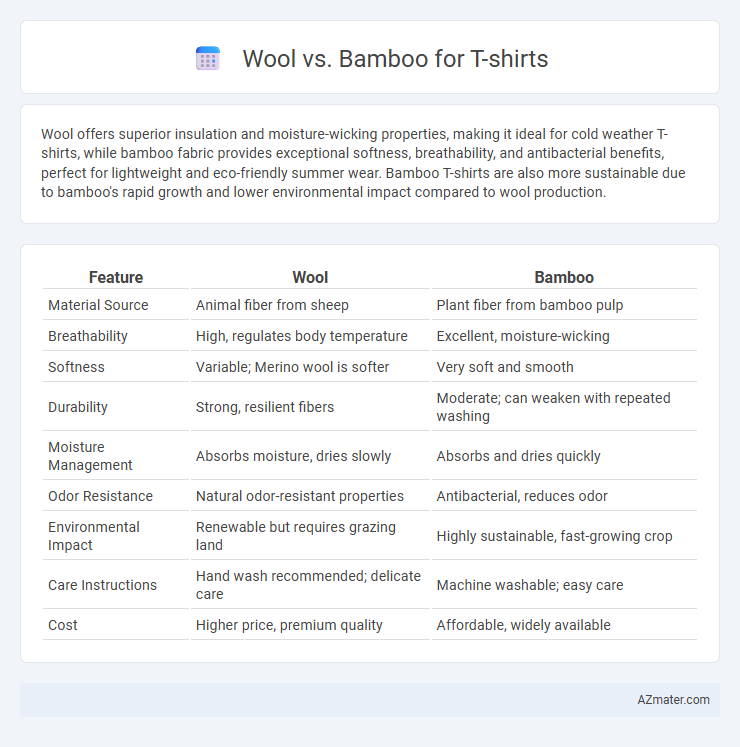Wool offers superior insulation and moisture-wicking properties, making it ideal for cold weather T-shirts, while bamboo fabric provides exceptional softness, breathability, and antibacterial benefits, perfect for lightweight and eco-friendly summer wear. Bamboo T-shirts are also more sustainable due to bamboo's rapid growth and lower environmental impact compared to wool production.
Table of Comparison
| Feature | Wool | Bamboo |
|---|---|---|
| Material Source | Animal fiber from sheep | Plant fiber from bamboo pulp |
| Breathability | High, regulates body temperature | Excellent, moisture-wicking |
| Softness | Variable; Merino wool is softer | Very soft and smooth |
| Durability | Strong, resilient fibers | Moderate; can weaken with repeated washing |
| Moisture Management | Absorbs moisture, dries slowly | Absorbs and dries quickly |
| Odor Resistance | Natural odor-resistant properties | Antibacterial, reduces odor |
| Environmental Impact | Renewable but requires grazing land | Highly sustainable, fast-growing crop |
| Care Instructions | Hand wash recommended; delicate care | Machine washable; easy care |
| Cost | Higher price, premium quality | Affordable, widely available |
Introduction: Wool vs Bamboo for T-Shirts
Wool and bamboo fibers offer distinct benefits for T-shirts, with wool known for its superior insulation, moisture-wicking abilities, and natural odor resistance. Bamboo fabric boasts exceptional softness, breathability, and eco-friendly properties due to its rapid renewability and biodegradability. Choosing between wool and bamboo depends on prioritizing thermal regulation and durability versus comfort and sustainable sourcing.
Fabric Composition and Source
Wool T-shirts are primarily made from natural animal fibers sourced from sheep, offering excellent insulation and moisture-wicking properties due to lanolin content. Bamboo T-shirts are crafted from bamboo pulp, a sustainable and rapidly renewable plant fiber processed into soft, breathable viscose or lyocell fabrics. The choice between wool and bamboo impacts comfort and environmental footprint, with wool providing warmth and bamboo delivering lightweight breathability.
Comfort and Softness Comparison
Wool offers excellent temperature regulation and moisture-wicking properties but can sometimes feel coarse against sensitive skin, affecting overall comfort. Bamboo fabric is renowned for its exceptional softness and smooth texture, providing a gentle touch ideal for all-day wear. Combining breathability and hypoallergenic qualities, bamboo often ranks higher in comfort and softness compared to most wool T-shirts.
Moisture-Wicking and Breathability
Wool, especially merino, excels in moisture-wicking by absorbing sweat vapor and releasing it into the air, keeping the skin dry and comfortable during physical activities. Bamboo fabric offers superior breathability due to its natural porous structure, allowing better airflow and quick drying compared to many synthetic materials. Both fibers provide excellent moisture management, but wool's temperature-regulating properties give it an edge in varying conditions, while bamboo is ideal for lightweight, breathable T-shirts in hot climates.
Thermal Regulation Properties
Wool offers superior thermal regulation due to its natural crimped fibers that trap warmth while maintaining breathability, making it ideal for cold and variable temperatures. Bamboo fabric excels in moisture-wicking and breathability, providing cool comfort in hot climates by efficiently dispersing heat and moisture. Both materials adapt well to temperature changes, but wool is preferred for insulation, whereas bamboo is favored for lightweight cooling.
Durability and Longevity
Wool T-shirts offer exceptional durability due to the natural crimps in wool fibers, which resist wear and retain shape over time, making them ideal for long-lasting use. Bamboo fiber T-shirts, while softer and more breathable, tend to have lower tensile strength and can degrade faster with frequent washing and stretching. Choosing wool ensures greater longevity in T-shirt wear, especially in rugged conditions or high-frequency use.
Environmental Impact and Sustainability
Bamboo fabric requires significantly less water and pesticides compared to wool production, making it a more eco-friendly option for T-shirts. Wool involves animal farming that contributes to methane emissions and land degradation, whereas bamboo grows rapidly and regenerates without needing replanting. Both materials are biodegradable, but bamboo's fast renewability and lower carbon footprint position it as a more sustainable textile choice.
Allergenicity and Skin Sensitivity
Wool fibers contain lanolin, which can trigger allergic reactions and cause itchiness or irritation for sensitive skin, making it less suitable for individuals prone to allergies. Bamboo fabric is naturally hypoallergenic and boasts smooth, breathable fibers that reduce the risk of skin irritation and are ideal for those with sensitive or allergic skin conditions. Choosing bamboo for T-shirts provides a softer, cruelty-free option with enhanced comfort and reduced allergen exposure compared to traditional wool.
Maintenance and Care Requirements
Wool T-shirts require gentle washing in cold water with mild detergent and should be air-dried flat to maintain fiber integrity and prevent shrinking. Bamboo T-shirts are easier to care for, as they can often be machine-washed on a gentle cycle and dried at low temperatures without losing softness or shape. Both fabrics benefit from avoiding bleach and fabric softeners to extend garment lifespan and preserve moisture-wicking properties.
Price Point and Value for Money
Wool T-shirts generally have a higher price point due to the cost of raw materials and specialized processing, offering exceptional warmth and moisture-wicking properties ideal for outdoor activities. Bamboo T-shirts, while more affordable, provide excellent softness, breathability, and eco-friendly benefits, delivering strong value for money in casual wear. Choosing between wool and bamboo depends on balancing budget constraints with desired performance features and sustainability preferences.

Infographic: Wool vs Bamboo for T-shirt
 azmater.com
azmater.com